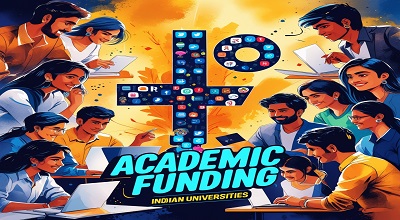Crowdsourced Academic Funding
Crowdsourced Academic Funding: In recent years, Indian universities have faced significant challenges in securing adequate funding for research, infrastructure, and student welfare initiatives. Traditional sources of academic funding, such as government grants and tuition fees, are often insufficient to meet the growing demands of higher education institutions. Crowdsourcing has emerged as a promising alternative to bridge this gap, enabling universities to raise funds directly from individuals, alumni, and the broader community.
This article explores the latest developments in crowdsourced academic funding in Indian universities, shedding light on its benefits, challenges, and future prospects.
Understanding Crowdsourced Academic Funding
Crowdsourced funding, or crowdfunding, involves raising small contributions from a large number of people, typically through online platforms. While traditionally associated with entrepreneurial ventures, this method has gained traction in academia, allowing universities to engage with their stakeholders and attract financial support for various projects.
Indian universities have begun leveraging crowdfunding to:
- Support research initiatives
- Enhance infrastructure
- Provide scholarships
- Promote community-oriented projects
Key Benefits of Crowdsourced Funding
1. Diversification of Funding Sources
Relying solely on government funding or tuition fees limits the financial flexibility of universities. Crowdsourcing provides an additional revenue stream, reducing dependency on traditional funding sources.
2. Community Engagement
Crowdsourcing fosters a sense of community by encouraging alumni, students, parents, and the general public to contribute to the university’s development. It creates a shared sense of ownership and pride.
3. Innovation in Research
With increased funds, researchers can undertake innovative and high-risk projects that might not receive conventional grants.
4. Increased Visibility
Successful crowdfunding campaigns can boost a university’s visibility, attracting more students, collaborators, and donors.
5. Speed and Accessibility
Crowdfunding platforms offer a quicker and more accessible way to raise funds compared to traditional channels, which often involve lengthy bureaucratic processes.
Latest Trends in Crowdsourced Academic Funding
1. Integration with Technology
Indian universities are increasingly using dedicated crowdfunding platforms such as Milaap, Ketto, and ImpactGuru. These platforms provide user-friendly interfaces, enabling donors to contribute seamlessly.
2. Alumni Networks as Key Contributors
Universities are tapping into their alumni networks to generate funds. Many alumni, inspired by a desire to give back, are contributing generously to initiatives that benefit current students and faculty.
3. Project-Specific Campaigns
Crowdfunding efforts are often focused on specific projects, such as building libraries, funding student exchange programs, or supporting research in niche areas like renewable energy and AI.
4. Social Media as a Catalyst
Social media platforms like Facebook, Instagram, and LinkedIn play a critical role in promoting crowdfunding campaigns, reaching a global audience, and attracting diverse contributors.
5. Transparency and Accountability
Donors demand transparency regarding how their contributions are utilized. Universities are adopting blockchain technology and other tracking tools to ensure accountability.
Challenges in Crowdsourcing Academic Funding
1. Limited Awareness
Crowdfunding is still a relatively new concept for many Indian universities, and awareness about its potential remains low.
2. Lack of Expertise
Designing and executing a successful crowdfunding campaign requires expertise in marketing, storytelling, and donor engagement—skills that many universities currently lack.
3. Regulatory Hurdles
Indian financial regulations can pose challenges to fundraising, especially when contributions come from international donors.
4. Risk of Campaign Failure
Not all crowdfunding campaigns succeed. Universities must invest significant effort in crafting compelling narratives to attract donors.
5. Ensuring Long-Term Sustainability
Crowdfunding is often project-specific and short-term. Universities must find ways to integrate it into a broader, sustainable funding strategy.
Success Stories of Crowdsourced Funding in Indian Universities
1. Indian Institute of Science (IISc)
IISc launched a crowdfunding campaign to support research in cutting-edge technologies, raising over INR 3 crore from alumni and well-wishers.
2. Banaras Hindu University (BHU)
BHU successfully crowdfunded a state-of-the-art library, receiving contributions from alumni across the globe.
3. IIT Bombay’s Hostel Renovation
IIT Bombay utilized crowdfunding to renovate its hostels, engaging alumni through personalized campaigns.
4. Student-Led Initiatives
Several student-led projects in Indian universities have been successfully crowdfunded, including solar-powered vehicles and community welfare programs.
Best Practices for Crowdfunding in Academia
- Clear Objectives: Define the purpose of the campaign and its impact.
- Engaging Narratives: Use storytelling to connect with potential donors emotionally.
- Leverage Alumni Networks: Engage alumni through targeted campaigns.
- Transparency: Provide regular updates on how funds are used.
- Utilize Social Media: Maximize reach through strategic social media campaigns.
- Recognize Contributors: Acknowledge donors publicly to build trust and goodwill.
The Future of Crowdsourced Academic Funding
Crowdsourced funding is set to play a pivotal role in the evolution of Indian universities. As awareness grows and technology evolves, more institutions are expected to adopt this innovative approach. Integrating crowdfunding into a broader financial strategy will be essential for sustaining its benefits.
FAQs
1. What is crowdsourced academic funding?
Crowdsourced academic funding is a method of raising financial contributions from a large number of people, often through online platforms, to support university initiatives such as research, scholarships, and infrastructure development.
2. Why is crowdfunding important for Indian universities?
Crowdfunding helps Indian universities diversify their funding sources, engage with their community, and attract resources for innovative projects and infrastructure improvements.
3. Which platforms are commonly used for crowdfunding in India?
Popular crowdfunding platforms in India include Milaap, Ketto, and ImpactGuru. These platforms provide user-friendly tools for universities to launch and manage campaigns.
4. What are some successful examples of crowdfunding in Indian universities?
Success stories include IISc’s research funding campaign, BHU’s library project, and IIT Bombay’s hostel renovation initiative.
5. What challenges do Indian universities face in crowdfunding?
Challenges include limited awareness, lack of expertise, regulatory hurdles, risk of campaign failure, and ensuring long-term sustainability of funds.
6. How can universities ensure transparency in crowdfunding?
Transparency can be achieved through regular updates, detailed financial reports, and the use of technologies like blockchain to track fund utilization.
7. What role does social media play in academic crowdfunding?
Social media platforms are essential for promoting campaigns, reaching a wider audience, and engaging with potential donors through compelling narratives and updates.
